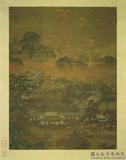明文臺香象皈依圖 軸
推薦分享
資源連結
連結到原始資料 (您即將開啟新視窗離開本站)後設資料
- 資料識別:
- 故畫000531N000000000
- 資料類型:
- 類型:繪畫
- 型式:靜態圖像
- 著作者:
- 文臺
- 主題與關鍵字:
- 奇石 象 傢俱(屏風) 宗教器用 服飾(對人) 蓮荷 菩薩
- 出版者:
- 數位化執行單位:國立故宮博物院
- 格式:
- 本幅 66.5x32.8公分、詩塘 24.3x32.9公分、全幅 53公分
- 關聯:
- 秘殿珠林續編﹝乾清宮﹞,第一冊,頁148&*故宮書畫錄﹝卷五﹞,第三冊,頁396&*故宮書畫圖錄,第八冊,頁67-68&*文臺,長洲(今江蘇州)人。字允承,號祝峰。文徵明(西元一四七○-一五五九年)第三子。為人慷慨,有豪士之風。山水、人物師李公麟。 一菩薩手持經卷趺坐於巨石之上,前有六牙白象鼻捲蓮花,供養菩薩。菩薩身軀拉長,巨石造形怪異,菩薩衣紋和白象的皮褶又似平行的線條表現,頗具變形之趣。全作筆墨高古,富於變化。 &* Wen T’ai (style name Yün-ch’eng, sobriquet Chu-feng) was a native of Ch’ang-chou, modern Suchou, Kiangsu province. He was the third son of the famous artist Wen Cheng-ming (1470-1559). He was a generous, unselfish person of outstanding intellectual capacity. He painted landscapes and figures in the style of Li Kung-lin, a famous northern Sung artist. A bodhisattva holds a sutra in his hands and sits cross-legged on a rock. In the foreground, a six-tusked white elephant holds lotus flowers with its trunk as an offering to the bodhisattva. The large rock is strangely shaped, and the clothing folds of the bodhisattva and the folds in the elephant’s skin which are depicted through parallel lines seem to have undergone a kind of transformation. The skilled brushwork in the entire painting possesses an antique flavor and is full of changes.
- 管理權:
- 國立故宮博物院
授權聯絡窗口
- 國立故宮博物院圖像授權、出版授權、影音資料授權-申請流程說明
http://www.npm.gov.tw/zh-TW/Article.aspx?sNo=03003061






